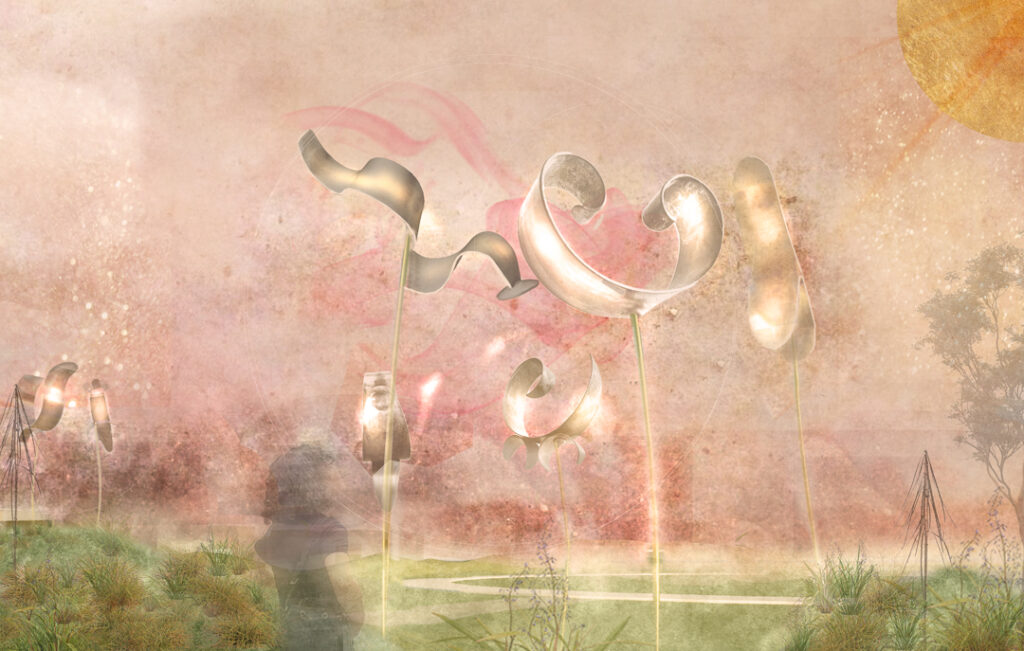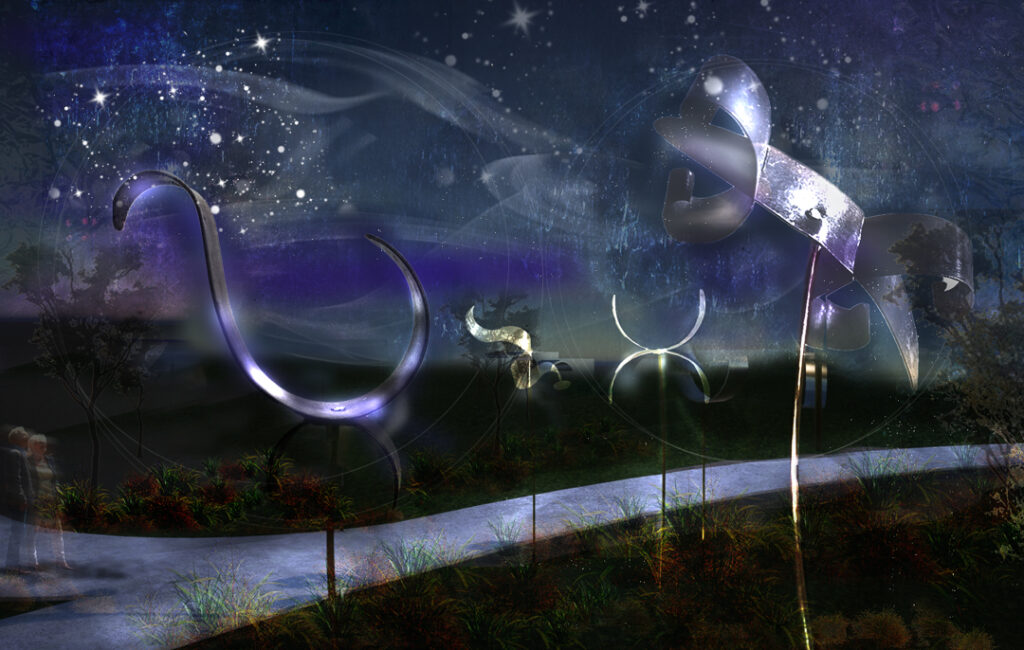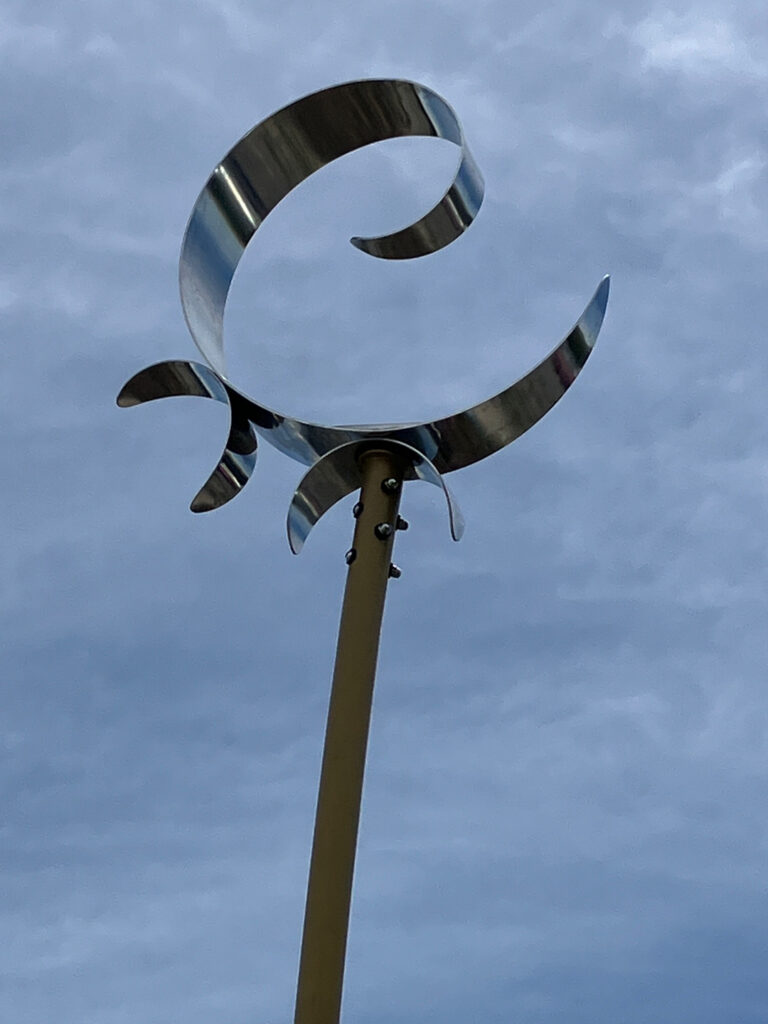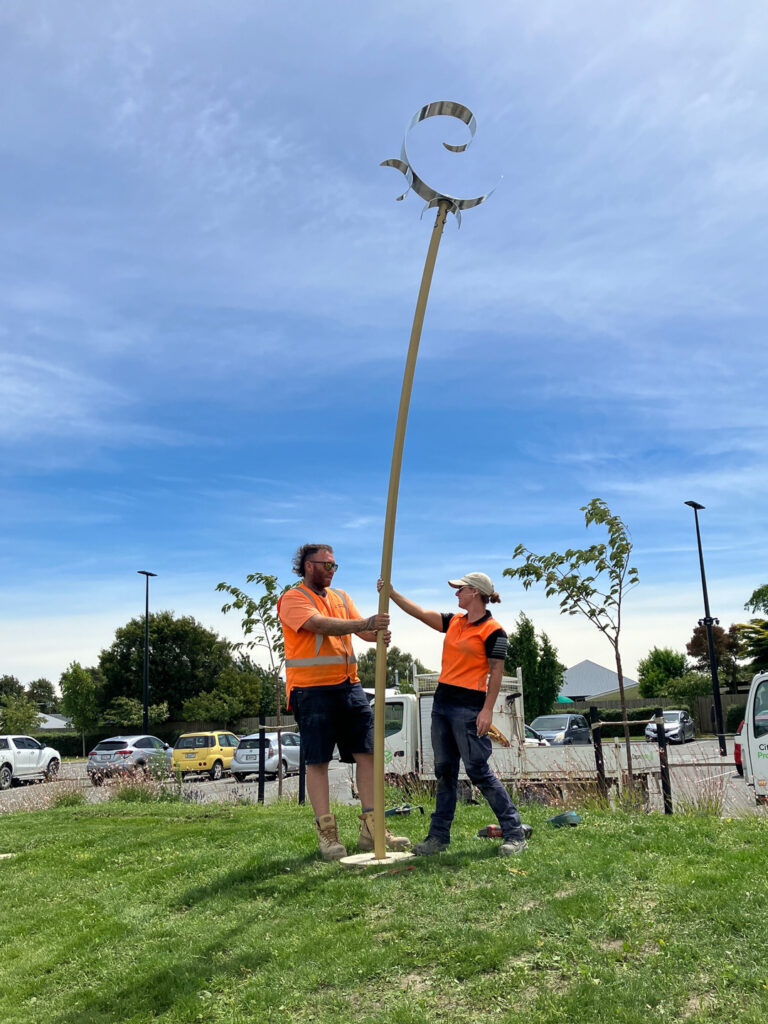
Areta Wilkinson, Toro Atua, 2023, new public artwork for Rolleston Town Centre, artist impression (render detail day). Image by Georgina Stokes.
Inspired by ancestral rock art, Areta Wilkinson’s public art installation recognises the Māori spirits that guard whenua.
Areta Wilkinson has an impressive history of adornment making, lasting nearly 30 years. Of the Ngāi Tahu – Ngāti Wheke iwi heritage, she focused particularly on jewellery’s role in connecting to whenua (land). This is underpinned by a strong connection to her Māori community. An example is her collective jewellery project, “Ngā Whatu Piataata: Stars in my Eyes”, which featured brooches woven from satin ribbon into a star shape that refers to Matariki. This was repurposed for “Arohanui (much love) for the whanau of Rapaki” to boost the spirits of a local Māori community recovering after the earthquake in 2011.
Elsewhere in Garland, you will find articles about her photogram work (here and here). This work seeks to translate sacred taonga into a jewellery form appropriate for everyday wear. More recently, the series of pendants “Ka Taka Te Wā – Time Passed” was made with stone tools from the Waimakariri and Rakahuri ancestral rivers.
Toro Atua (sentinel) is a public artwork that scales up her designs for the town centre of Rolleston (Tauwharekākaho) near Christchurch (Ōtautahi). These works are based upon the cultural narrative Ngāi Te Ruahikihiki ki Taumutu gifted to the Selwyn District Council for the community hub. It references the whakapapa, kōrero and mahinga kai traditional food and resource practices. The narrative celebrates the “life giving forces” including the eel, lamprey, whitebait and black flounder. Eels in particular have left a permanent mark in the landscape as the eel weir of the ancestor Te Rakihouia. The site of the artwork functions as a pou whenua or identity marker for the traditional trails across the local landscape.
- Areta Wilkinson, Toro Atua, 2024, new public artwork for Rolleston Town Centre (detail); photo: Areta Wilkinson
- Areta Wilkinson, Toro Atua (detail), 2023
Toro Atua takes design inspiration from the ancestral rock art of Te Waipounamu (South Island). They are a key reference for Areta: “They’re like the first art galleries. They’re the first mark-making on this island.”
The designs are realised in 20 light-reflecting stainless-steel figures, mounted on tall, slender poles to vibrate with life, shimmering slightly in the air far above people’s heads. The tallest of these is four metres high and the 20 figures are arranged in groups throughout the reserve, leading people through the landscape and indicating areas of importance.
Eels play a key role in the cultural ecology of the Selwyn area. Farming has impacted water quality and the eel populations, thanks to nitrates running off into local lakes. For Areta, this is more than just an environmental issue, “It’s a threat to traditional cultural practices.” The lighting plan for Toro Atua is designed to celebrate traditional seasonal practices of the maramataka (Māori lunar calender) with one special contingency to turn off the lights signifying when eels are on the move. “At Wairewa (Lake Forsyth) in autumn when the eels cross the shingle bar at Birdlings Flat, they turn the lights off so as not to confuse the eels.” This is one way Toro Atua can be informative and reflect cultural lifeways.
To ensure the ongoing care for Toro Atua, the council will accept a tikanga (protocol) plan to maintain the meaning of Toro Atua. Areta’s work goes beyond the objects themselves: “I have created a tikanga plan as part of this package to help guide how this taonga work is culturally warmed in perpetuity. The main reasons behind this is to keep the cultural link to source communities alive & relevant … and for the artwork to be useful to increase cultural understanding. At the opening community event, the artwork will be enhanced by Ngāi Tahu storytelling. It is an opportunity to elevate and share Māori knowledge. We’re telling different stories with this work.”
The inaugural celebration of Toro Atua coincides with Matariki, the Māori festival that heralds the arrival of the Pleiades constellation, which is now a national holiday. With a jewellery sensibility, Areta Wilkinson has been able to create objects that connect sky and land, symbolising ongoing care for the whenua that gives life.

Areta Wilkinson, Toro Atua, 2023, new public artwork for Rolleston Town Centre, artist impression (render detail night). Image by Georgina Stokes.
About Areta Wilkinson
 Areta Wilkinson’s practice explores whakapaipai concepts of Māori personal adornment in the context of bicultural New Zealand. She is concerned with histories of contact, tribal knowledge, genealogical and maker relationships between the cultural production of ancestors and her own objects. Her recent work represents an ongoing investigation into the history of Māori wearable taonga (prized possessions) particularly in regard to her iwi community in Te Waipounamu, the South Island. Areta’s practice extends over 28 years. Her work is seen in national galleries and collections such as Auckland Art Gallery, Auckland Museum, Dowse Art Museum and Museum of New Zealand Te Papa Tongarewa. A design lecturer in jewellery 1995-2008, she completed a PhD in Creative Arts through Massey University Te Putahi-a-Toi School of Maori Studies 2014 and is an independent artist. She is represented by Two Rooms Gallery, Auckland and The National, Christchurch.
Areta Wilkinson’s practice explores whakapaipai concepts of Māori personal adornment in the context of bicultural New Zealand. She is concerned with histories of contact, tribal knowledge, genealogical and maker relationships between the cultural production of ancestors and her own objects. Her recent work represents an ongoing investigation into the history of Māori wearable taonga (prized possessions) particularly in regard to her iwi community in Te Waipounamu, the South Island. Areta’s practice extends over 28 years. Her work is seen in national galleries and collections such as Auckland Art Gallery, Auckland Museum, Dowse Art Museum and Museum of New Zealand Te Papa Tongarewa. A design lecturer in jewellery 1995-2008, she completed a PhD in Creative Arts through Massey University Te Putahi-a-Toi School of Maori Studies 2014 and is an independent artist. She is represented by Two Rooms Gallery, Auckland and The National, Christchurch.




